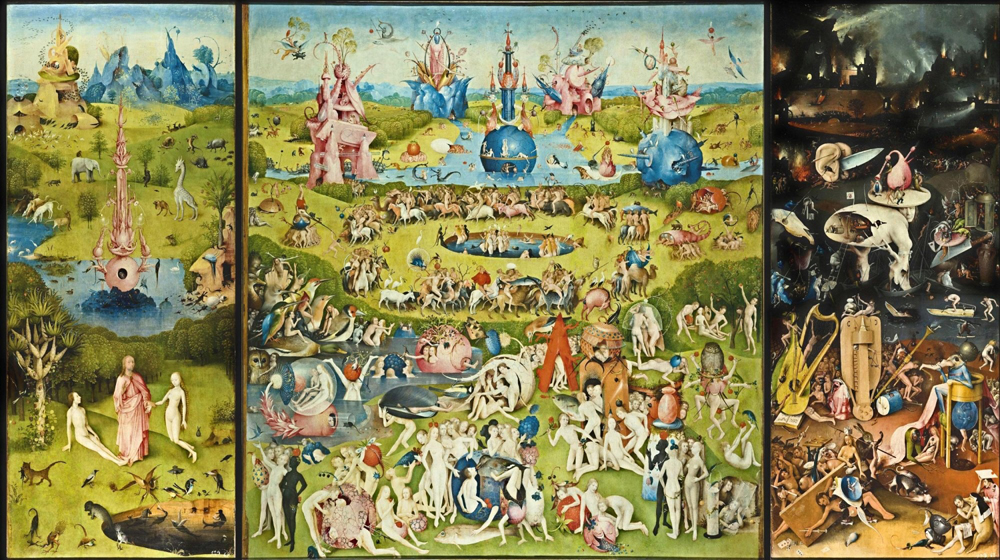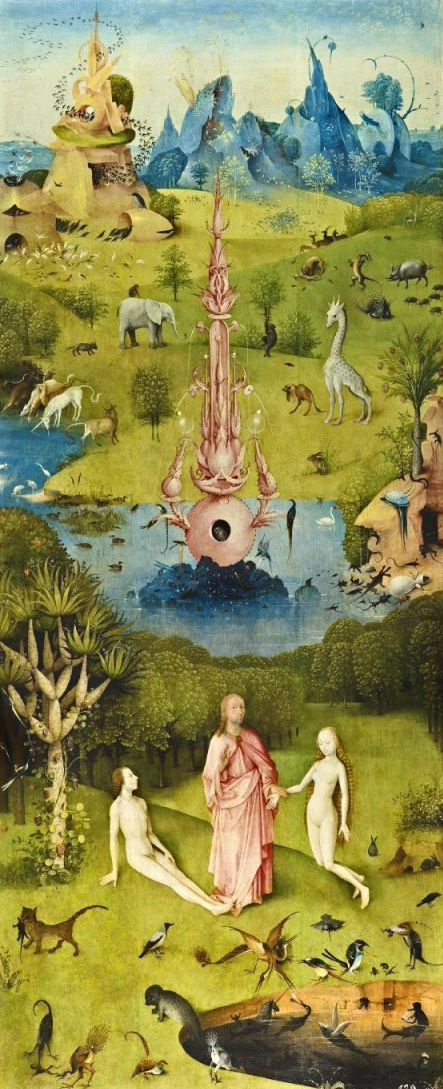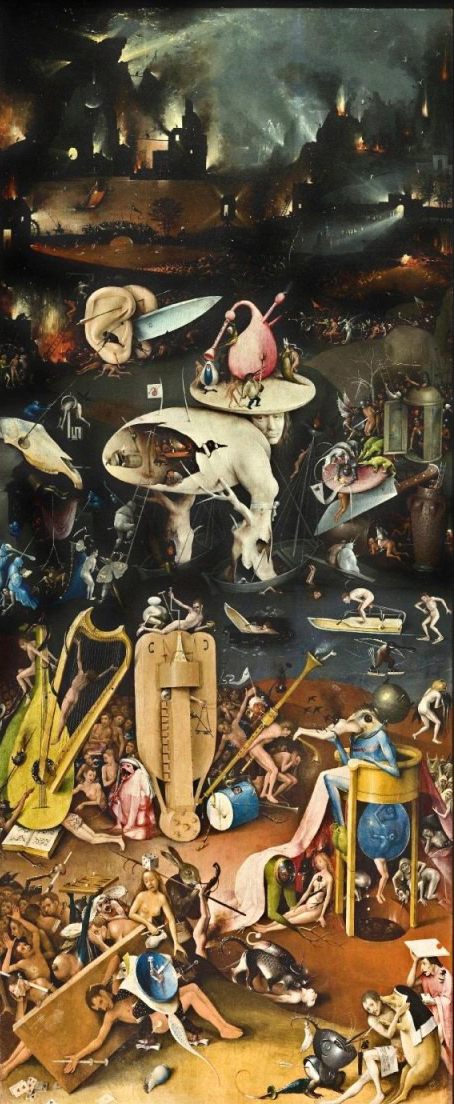|

|
The two outer panels, known as the "Creation of the
World," reveal God's integral formation and methodical
shaping of the Earth after three days. Hieronymous Bosch positioned
God, furnished with a golden crown upon His head, symbolic of
both His heavenly creativity and ultimate powers, and draped
in a blue gown, symbolic of His divine nature, above the Earth
to illustrate His supreme ruling over the world. The Earth,
portrayed as a transparent sphere, unveils God's ability to
oversee the developmental progression of His masterpiece and
points toward the unaccepted viewpoint of the world as having
been molded into a rounded, not flattened, shape. The left panel
shows God's creation of light which heralds the morning's dawn,
eluding to the concept of hope; the right panel tells of God's
creation of darkness that warns of evening's falling, hinting
at the concept of despair; the left and right panels collectively
mark how day and night were begun on the first day and note
the underlying struggle between the forces of good and evil.
The water and sky on either panel represent their formation
in the midst of the second day. The land and sea and vegetation
(pinpointing the ability of trees to bear fruit, whose seeds
may later evolve into human descendants of nature) establish
their creation in the third day. God's position within a noticeably
lighter background, vaguely resembling the shape of a halo,
may symbolize the graces of heaven, while the Earth's position
amongst the obviously darker background gives insight in respect
to man's nervousness of the unknown and man's dread of the plagues
of hell.
|
|
|
The inner left wing, named "Paradise,"
depicts Christ's introduction between Adam and Eve from within
the Garden of Eden. The mountainous formations in the background
of the picture's landscape resemble either glass towers or ice
sculptures, illustrating the fragility of nature and emphasizing
the brevity of life; however, a few critics believe the rocks
to symbolize medieval alchemical vials, perhaps noting the most
significant religious and historical occurrence that would inevitably
change the governing laws of humanity. Young trees, representative
of lush new beginnings, are abundant within the vegetation of
the painting, making known the degree to which life flourished
in the Garden. The exotic creatures, most notably the elephant,
the unicorn, the giraffe, and the swan, reveal similarities
between human physiology and animal form-the bodily compositions
of the elephant and the unicorn have a likeness to the male
structure, and the physical makeups of the giraffe and the swan
are unique to the female anatomy. Modern research claims that
God banished numerous unruly angels from the graces within the
Kingdom of Heaven, and in doing so, ordered them to descend
upon and forever live on the Earth as repulsive insects; therefore,
the swarm of formerly rebellious angels invading the Garden's
backdrop unmasks the haunting evil that will continually plague
mankind. The multiple amphibians surfacing from the pond reinforce
the belligerent demons that could wreak great havoc upon the
Earth. Near the point in which God lets the seated Adam meet
the bowing Eve, ferocious creatures violently turn upon and
maliciously kill each other, representing the beastly chaos
lurking within the depths of hell.
|

The central image, titled "The Garden of Earthly Delights,"
narrates a bewildering perspective of sinful humanity when free
of moral restraint. Nude men and women parade upon animals' backsides
throughout the illustration, symbolic of humanity's ravenous greed
for carnal desires. Couples dance in the waters of the pond, expressing
admiration for the marvelous intricacies of the human body. A
few individuals do engage themselves within sexual orgies, perhaps
rejoicing in the lawless atmosphere of the Garden. The voluptuous
fruit utilized by the naked men and women in the landscape, strategically
positioned about their genitalia, communicates the sensuality
of the human body; however, viewed from a more religious level
of interpretation, it depicts the unending cycle of Adam and Eve's
sin, whereby everyone serves as a prisoner to his or her appetite.
Males and females innocently nurture the owl, a longtime symbol
of witchcraft, unconsciously damning themselves to eternal punishment
in hell. The occasional Negroes within this sinful Garden, exalting
in this mass chaos, represented the bodily personifications of
evil. |
|
The right wing, called "Hell,"
illustrates the barbaric mechanisms of torturous punishment,
carried out by demons from a half animal, half machine nature,
in the Garden of Satan. Architecture is completely engulfed
by flames, symbolizing the destruction within orderly religious
hierarchy-the precious grace in the Lord's Kingdom of Heaven
are now unobtainable, while the horrid imprisonment from within
the depths of Satan's Hell became realistic. Massive numbers
of individuals try running from the unrelenting punishment awaiting
them in hell, representing the conquering finality of evil,
showing domination in the battle with good. Grotesque mutilation
of bodily parts displays the unfathomable level of satanic torture
needed in redemption of immoral human folly. The crucifixion
of men by snakes upon instruments kin to a harp and a lute portrays
their retribution for ignorance of Jesus' death in the name
of evil. Due to Hieronymous Bosch's firm religious morals, his
triptych The Garden of Earthly Delights and its wings "Creation
of the World," "Paradise," "The Garden of
Earthly Delights," and "Hell" presents a visual
allegorical sermon eluding to the haunting consequences in not
obeying the Lord's beseeching.
|
|
Bibliography
1 Dec. 2002 <http://www.tabula-rasa.info/DarkAges/Bosch.html>
Janson, H.W. History of Art. New York: Harry N. Abrams, Inc., 1986.
Ward, Kyla. "Hieronymous Bosch, The Unearthly Gardener." Tabula
Rasa. 2002.
Gombrich, E.H. The Story of Art. Englewood Cliffs, New Jersey: Prentice-Hall,
Inc., 1985.
Janson, H.W., and Joseph Kerman. A History of Art & Music. New York:
Harry N.Abrams, Inc., 1968.
Harden, M. "Hieronymus Bosch." The Artchive. 1 Dec. 2002 <http://www.artchive.com/artchive/B/bosch.html>.
back
to 2002 projects
- home - next
|




